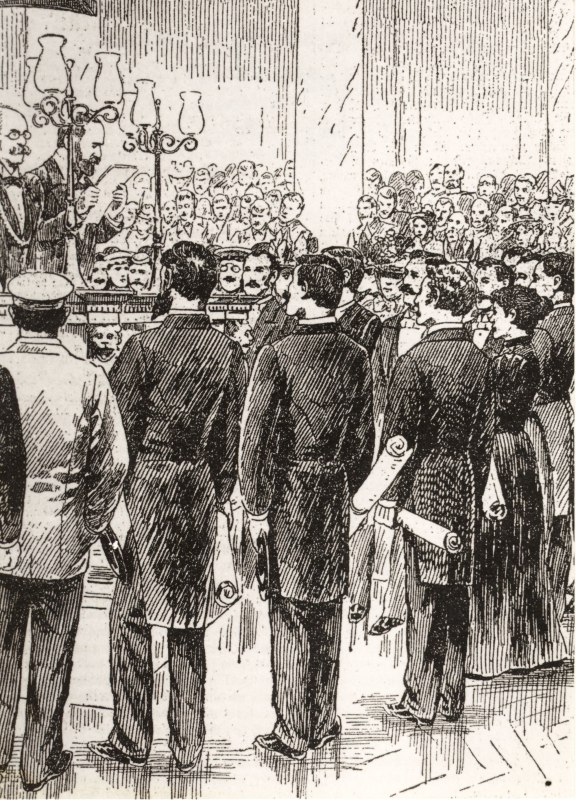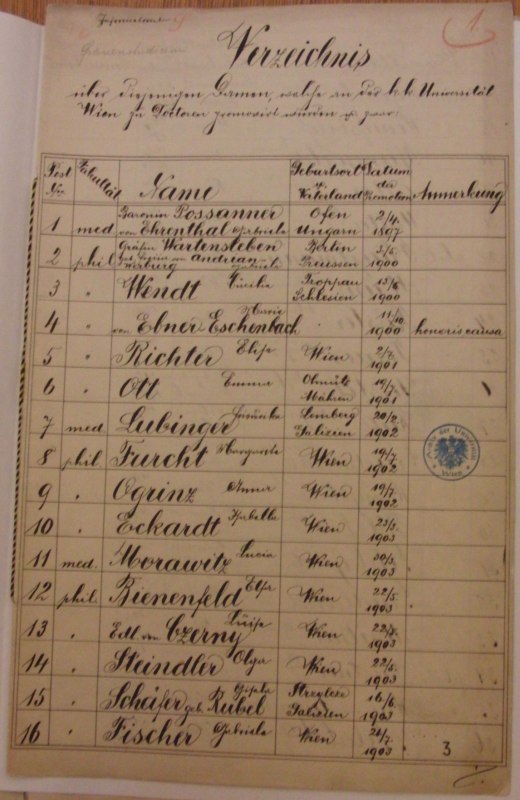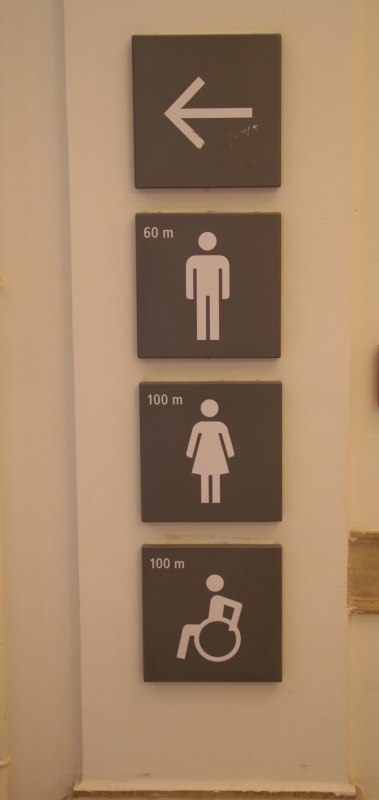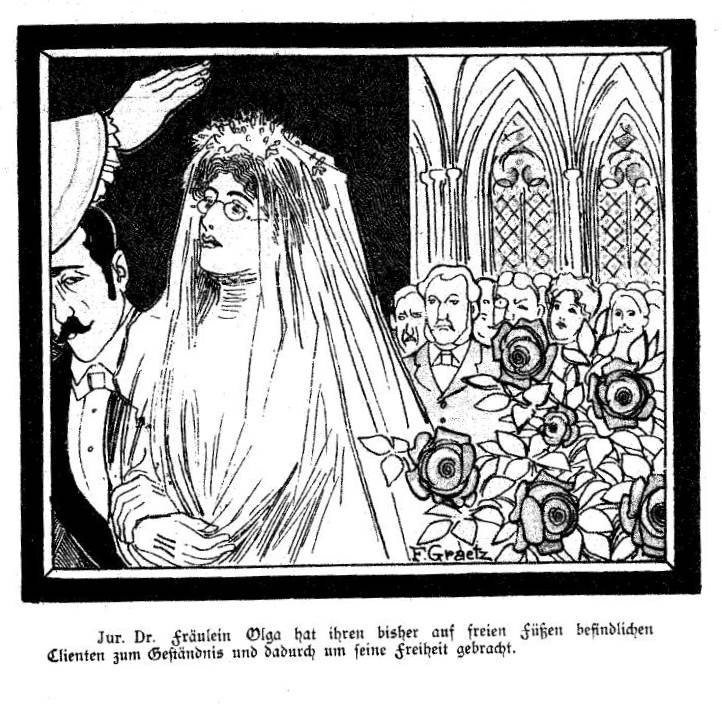Female enrolment
When the Philosophical Faculty was the first institution of the University of Vienna to open itself to the enrolment of women in the academic year of 1897/98, more than 500 years had already passed since the university’s founding.
At first, three women enrolled. The ratio of women to men at that point was 1:183. Today – varying by discipline – one can speak of a ratio of about 1:1. This article is a look at the developments in slightly more than a century in which women have had access to the University of Vienna, a societally highly respected educational and entitling institution.
Scientifically certified
Up to the 1880s the “low cerebral capacity” of women was used as a scientific argument against their admission to the studies. The capabilities of individual women were seen as exceptions and one cautioned against extrapolating from their abilities to the general population. However, progress could not be stopped. In 1900, only three years later, women were also admitted to the Medical Faculty.
In the course of this, a linguistically and culturally varied picture presented itself. The female student body was not only made up of women from mainly German-speaking parts of the monarchy, but instead – particularly in medicine – the number of female students from Galicia had surpassed that of those from Vienna. With the political changes, especially in the 1930s, this picture was transformed as well. In regard to the studied subjects, a focus on philosophy followed by psychology and pedagogy can be observed. This was due to, on the one hand, the philosophical oral exam being mandatory for all doctoral studies in the humanities and natural sciences, and on the other hand to the fact that these subjects were also compulsory for all teacher training studies, which were attended by a large percentage of women.
In 1918/19, the year in which women also received the right to vote in the newly proclaimed Austrian Republic, the ban on women’s enrolment fell at the Faculty of Law, the study at which was a prerequisite for almost all higher public official positions as well as the entry requirement for the legal professions. A little later, in 1928, women were also allowed to study at the Faculty of Protestant Theology, with the Faculty of Catholic Theology following suit in 1945. Compared to other European countries, Austria was the last country apart from Prussia to admit women to universities.
From 1:183 to 1:12 to 1:3
Before the beginning of the First World War, the ratio of female and male students had already improved to 1:12 in 1914; in the academic year of 1938/39 it was 1:3.
Most female students came from intellectual middle-class families and were disproportionately Jewish when compared to the rest of the population. This phenomenon characterizing the female pioneers among the students naturally left its mark in the context of the university reforms after Austria’s “Anschluss” to National Socialist Germany in 1938. Of all students expelled from the university, the percentage of women persecuted as Jews was 24.4%, with the percentages varying from faculty to faculty. With almost 59% of all female students, the Philosophical Faculty had the largest number of women. 14% of the women at the Philosophical Faculty were expelled, compared to 19% of the men. At the Faculty of Law, 11.8% of the expelled students were women, at the Medical Faculty it was 24%, while of all students expelled at the Philosophical Faculty as many as 46.3% were women. At the same time, the relative number of female students actually rose during National Socialism – despite its ideological goals.
Numerous students became victims of the Shoah; 25 female students of the University of Vienna were deported to concentration or extermination camps where they were killed..
“Making the conditions dance”
In the academic year of 1945/46, due to the consequences of the Second World War and National Socialism, the ratio of female and male students at the University of Vienna was at 1.4:1; in the academic year of 1955/56 it changed back to 1:2.4.
In the 1960s and 1970s, an “educational explosion” transformed the situation, making the “conditions dance”. Access to university studies was facilitated for people from previously more uneducated classes, leading to an exponential growth of the number of female students in the second half of the 20th century. In the winter semester of 1955/56 there were 1,786 female students compared to their 4,206 male colleagues, while in the winter semester of 1980/81 the numbers already almost drew level with 20,237 women to 21,111 men.
At the turn of the millennium, in the academic year of 2000/01, significantly more women than men began a course of studies. In absolute numbers, 15,718 female students clearly outnumbered the 10,438 male students. At the graduate level, this trend continued: 3,640 women and only 2,231 men completed their studies. In the academic year of 2012/13 women surpassed the 50-percent-mark. In the diploma and teacher training studies, as well as in the bachelor and master’s courses they numbered around 64%, in the doctoral studies the percentage was at 54%. This decline in the percentage of women among graduates of doctoral studies can be seen as a first hint at the leaky pipeline – a decrease in the number of women proportional to the hierarchical level and the potential salaries – which points towards structures and practices that make it difficult for women to reach the highest levels of the academic career ladder.
-

Graduation of Gabriele Possanner, 2 April 1897; The validation of her Swiss doctorate was the first graduation of a woman at the University of Vienna.
-

Verzeichnis promovierter Frauen an der Universität Wien, 1897–1923
Anfangs wurde die Promotion von Frauen zu Doktorinnen noch als so außergewöhnlich betrachtet, dass die Universität Wien für Berichtszwecke eigene...
-

Frauen an der Universität Wien 1968, Eröffnung Universitätsball im Arkadenhof
Bei der Inszenierung der Eröffnung des Universitätsballs 1968 gehen die Frauen an der Hand der Männer, drehen Kastalia, der mythologischen Wächterin...
-

Plakat zu 100 Jahre Frauenstudium in Österreich 1997
Österreich war 1897 fast das europäische Schlußlicht, als Frauen erstmals an Universitäten zum Studium zugelassen wurden.Seitdem studieren und...
-

Wegweiser beim Elise Richter Saal, 2013
Der Weg zu K - Karriere wie Klo - war/ist für Frauen länger an der Universität
Last edited: 08/26/21

